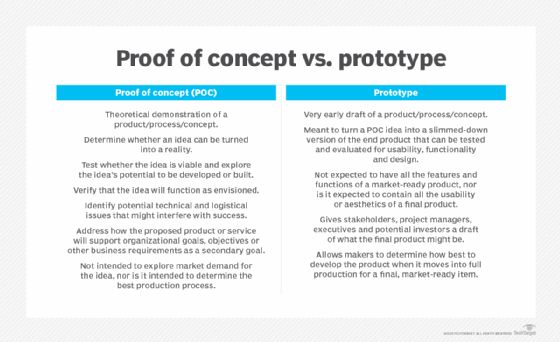MVP vs. prototype: What's the difference?
The key difference between a prototype and a minimum viable product is that a prototype is not intended for market distribution, while an MVP is. A prototype is the result of an effort to see if an idea is feasible and viable given the resources at hand. With MVP, feasibility and viability are already established, and the goal is to produce a polished, market-ready product.
In contrast to an MVP, a prototype can have known bugs and only implement partial functionalities. MVPs must be polished, fully implement all agreed upon functionality and be ready for market distribution.
What is a minimum viable product?
The idea behind a minimum viable product, sometimes called minimally viable product, is that it provides all of the key functionality an end user needs to solve a problem and convinces them to purchase and use the product.
Entrepreneurs and product owners often have grandiose visions of the products they want to build, while investors want to quickly bring their products to market. Furthermore, all stakeholders in a product development effort want to know if their idea is feasible and can generate a revenue stream. It is therefore important to put a functional product on the market and into the hands of end users early.
Development teams that build for MVP focus on the key features and functions that are necessary to create a scaled-down version of the full product that is still useful and sellable. They not only implement the core functionality, but also fix all bugs, address every corner case and fulfill various nonfunctional requirements such as usability, performance, compliance and security. In stark contrast to MVPs, prototypes don't typically fret over nonfunctional requirements.
What is a prototype?
The goal of a prototype is to simply prove the technical feasibility of a concept or an idea. It is not to produce a polished, market-ready product. Instead, it is to see if it's possible to implement a concept with available resources, which might include technology, tools and funding.
Prototypes are created early in the product development process. In fact, prototypes might be created before the formal product development process begins. Perhaps a passionate individual seeks funding and hopes to demonstrate the feasibility of their concept to the world.
Prototype vs. a proof of concept
Prototypes typically implement a higher level of functionality than a proof of concept, but they are not nearly as polished or functional as MVPs.
A prototype is really designed to garner feedback and input from stakeholders and investors. Prototypes are only shown to potential customers to create enthusiasm for a future product release.

Prototype and MVP comparison
Consider the following ways to conceptualize the differences between a prototype and MVP:
- A prototype is often created at a fraction of the scale of the envisioned product to save costs. An MVP must be full-scale.
- A prototype might use low-cost materials to save money. An MVP release must meet quality standards that consumers expect.
- A prototype might leave out key functionality or only partially perform tasks. An MVP release must fully support all promised and committed features.
- An MVP is expected to be sold to customers; a prototype's target is internal stakeholders.
- A prototype might take days or weeks to build, while a minimum viable product takes months.
There's no rule that says a prototype can't eventually be put on the market, but that's not the objective of a prototype effort. That's the MVP's objective.
Here's the bottom line: A prototype is the result of developers experimenting with various tools, technologies and resources at their disposal to see how feasible it is to implement an idea or concept. An MVP effort has already established the idea's feasibility, and the goal of an MVP effort is to bring a working product to market.
Darcy DeClute is a technical trainer and Agile coach who helps organizations apply Scrum-based principles to adopt a modern DevOps stack. She is a certified Professional Scrum Master (PSM), Professional Scrum Developer (PSD) and Professional Scrum Product Owner (PSPO), and author of the Scrum Master Certification Guide.


